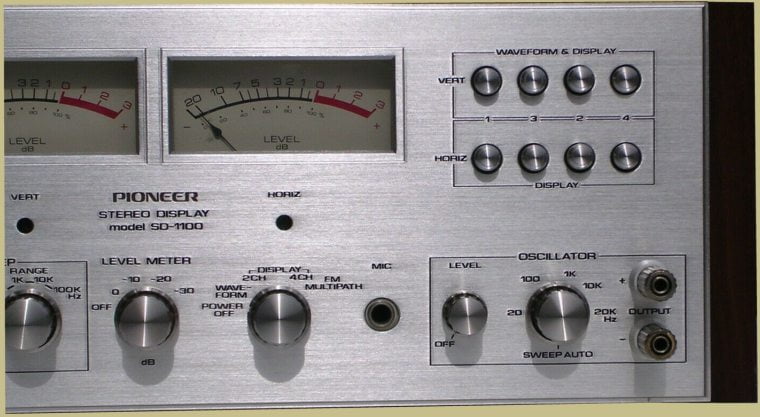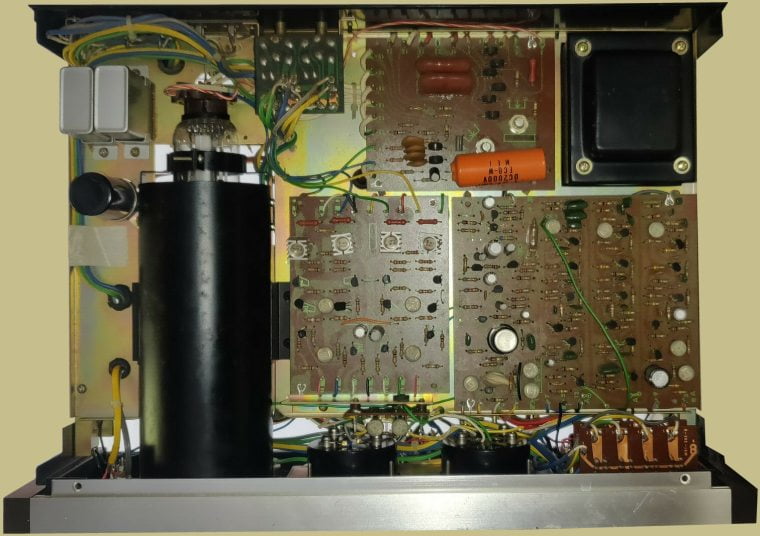
This Pioneer SD-1100 isn’t actually a receiver but I find it to be a fascinating piece of equipment that is closely related to the world of vintage receivers. It’s not something that the average stereo buyer would purchase but is something a pure audio enthusiast or tech tinkerer would. It’s called a Stereo Display Unit “for measurement and scoping of all audio components and stereo characteristics.” It’s basically a simplified oscilloscope and was on the market from 1972 until around 1974. It is the successor to the SD-1000 and, unlike the SD-1000, it can analyze 4 channels at once.

Most oscilloscopes are ugly but the Pioneer SD-1100 is a beautiful piece of equipment. The silver face, beveled knobs and wood side panels give it a rich look. There was also an optional CM-01 electret condenser type, wide frequency microphone to use in your listening room.
What can you do with the SD-1100? Well, you can:
- Observe stereo display
- Test for distortion
- Test channel balance
- Use FM multipath function to adjust and minimize signal distortion
- Check azimuth on a cassette deck
- Measure a voltage level
- Measure phase shift via a Lissajous pattern
- Measure stereo sound via difference in level of output signals
- Check the frequency response of a cartridge when playing a record
- View 4-channel sound fields on the cathode display
- Check the sensitivity, acoustic frequency response and directional characteristics of your speaker system

The unit incorporates an easy to read, clear cathode ray tube. The engineers even designed a spot killer circuit that reduces the pattern brightness when the vertical and horizontal amplitude is extremely reduced. That little bit of engineering thoughtfulness keeps the fluorescent materials in the scope from degrading more quickly over time than they otherwise would.
When set to Sweep-Auto the built in audio oscillator will sweep from 20-20,000Hz in as little as 25 seconds. There is also a wide frequency amplifier for a microphone. The SD-1100 has two large level meters. Both have 10dB step attenuators. They can cover a measurable signal range from 3mV to 30V and can be used as output level meters or volt meters.

As you can see there are simple button style input signal switches on the right hand side of the front panel. Use the 4-channel input terminals on the back panel and set the selector switch to 4CH and you’ll see a 4-channel sound display on the scope.

The vertical and horizontal amplifiers have the same gain which makes it easy to view Lissajous wave forms which is useful for analyzing phase shift.

The SD-1100, or Stereo Display Unit, is all transistorized. There are no tubes other than the cathode ray tube so it produces very little heat.
Below is the top view of the interior showing the cathode ray tube, vertical amp section, horizontal amp section, audio oscillator section and spot killer and power supply circuit.

The bottom view shows the 4-channel display amp section, microphone amp section, meter amp section and power supply unit. It’s a very clean and well laid out design.

The Pioneer SD-1100 isn’t something your average stereo purchaser would buy. But, someone who wanted to calibrate their audio system to near perfection in order to achieve ultimate sound performance would want this piece of equipment badly. It can be used with amplifiers, tuners, speakers, cartridges, tape decks and, of course, receivers.

The Pioneer SD-1100 is a very intriguing piece of equipment that is integral to the world of vintage audio and audio enthusiasts. If you just want to plug in a receiver and listen to music then you don’t need an SD-1100. But, if you want to tune your equipment and optimize your listening space with regard to speaker placement then the Pioneer SD-1100 would be extremely useful. Not to mention the unbelievable conversational quality and coolness factor that goes along with it. Good luck finding one these days though. Not many were sold back in the day so they are pretty rare now. If you do find one it will most likely be very expensive.


That is some cool shit. Thanks for sharing
Just listed mine on eBay UK
Has it sold?
I have one for sale if your interested
I never knew Pioneer had this type of unit until I saw one for sale on eBay. That is definitely a very cool conversation piece, not to mention would come in very handy for really optimizing someone’s equipment.